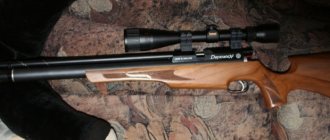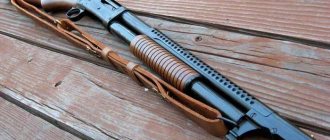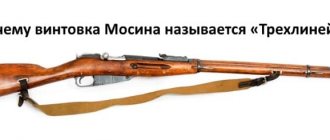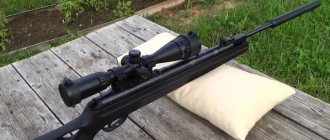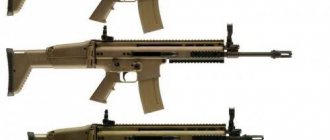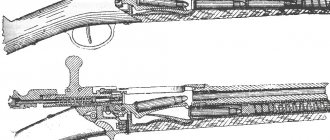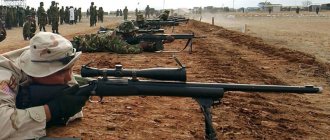The FG 42 rifle was a real breakthrough for its time. It was developed specifically for German paratroopers and was actively used during the Second World War. The army leadership of that time sought to create a powerful and long-range weapon that would be effective in close combat.
The FG 42 model has become just such a weapon, and although it is now practically not used for military operations, it is of interest to firearms enthusiasts.
Technical characteristics and use of the FG 42 rifle
In terms of technical characteristics, this assault rifle fully met the needs of the German army of that time. It was relatively light (4.2 kg) and could fire 900 rounds per minute.
Figure 1. The FG 42 rifle was created during the Second World War
The effective firing range of the model was 500 meters, which was quite enough for German paratroopers. The ammunition also included a removable box-shaped carbine for 10 or 20 rounds (Figure 1).
In the context of warfare in the modern world, such weapons may seem outdated, but for that time the creation of such a rifle was a real breakthrough.
Automatic rifle FG-42 (Germany)
Rifle FG-42, first model. bayonet in stowed position.
Rifle FG-42, second model. bayonet in firing position.
| FG-42-1 | FG-42-2 | |
| Caliber | 7.92×57 mm | |
| Length | 937 mm | 1060 mm |
| Barrel length | 508 mm | 525 mm |
| Weight without cartridges | 4.38 kg | 5.05 kg |
| Rate of fire | 900 rounds per minute | 600 rounds per minute |
| Shop | 10 or 20 rounds | |
The FG-42 automatic rifle (Fallschirmjagergevehr 42, literally “parachutist rifle, model 1942”) is a very interesting, although not the most successful example of small arms developed in Hitler’s Germany during the Second World War. The German airborne troops were, in their way, the elite of the German military machine. Organizationally, they were part of the Luftwaffe (German Air Force), while the equipment of Goering's paratroopers with weapons was carried out largely independently of the German army. Initially, the standard models that were in service with the German paratroopers did not satisfy them due to their specificity - the paratroopers had to operate with a minimum of equipment and weapons, while they required maximum firepower. Therefore, at the beginning of 1942, the RLM (Reich Air Ministry) issued a requirement for an automatic rifle, capable of replacing not only the standard Mauser K98k carbine, but also a light machine gun in the hands of a paratrooper. At the same time, the new rifle had to be able to fire in bursts and use a standard 7.92x57mm rifle cartridge. Need to say. that the Department of Armaments of the Army (HWaA) treated these requirements with caution, understanding their low reality, and proposed automatic carbines that were being developed at that time for the intermediate cartridge 7.92x33mm Kurtz, which later grew into the Stg.44 assault rifle (assault rifle), which were then being developed for arming paratroopers. Nevertheless, representatives of the Air Force insisted on their position, and two well-known companies immediately began developing new weapons - Rheinmetall-Borsig and Krieghoff. In mid-1942, the first prototypes of the new rifle entered testing, where it turned out that the Rheinmetall-Borsig rifle had advantages over its competitor. The Air Force ordered a pilot batch, but since Rheinmetall-Borsig was already overloaded with other military orders, the production contract was transferred to a competitor, Krieghoff. Before the beginning of 1944, between 1,000 and 2,000 FG-42 rifles of the first model were produced. By this point, it became clear that the original FG-42 rifle was too light to be used in burst fire; in addition, it was very complex and expensive to produce. Therefore, Krieghoff engineers modified the FG-42 rifle, creating the so-called second model. The modified rifle was distinguished by an elongated barrel with a modified muzzle brake, a different method of installing reinforced bipods, and a modified shape of the pistol grip and butt. The receiver became stamped rather than milled, and the stamped metal stock was replaced with a wooden one. The rifle became heavier, but was still expensive and difficult to manufacture, and could not match the effectiveness of automatic fire with light machine guns. About 5,000 FG-42 rifles of the second model were produced before the end of the war. In the post-war period, the development of these rifles completely ceased, but their mechanism served as the basis for the creation of the not very successful American M60 light machine gun.
The FG-42 automatic rifle is built on the basis of gas-operated automatics, with a gas piston with a long stroke located under the barrel. The second model FG-42 rifle had a manual gas regulator. Locking was carried out by turning the bolt to 2 lugs. Automatic fire was carried out from an open bolt for better cooling of the barrel, and single shots were fired from a closed bolt for better shooting accuracy. A distinctive feature of the rifle’s design was the enlarged chamber, which, due to the deformation of the cartridge case, made it possible to slightly reduce the peak pressure of the powder gases when fired. The result of this innovation was the characteristic deformation of spent cartridges, traditionally made of brass. When using cartridges with a steel sleeve, such a solution led to cracks and ruptures of the sleeves, and as a result, to increased contamination of the chamber with combustion products. Box-shaped double-row magazines were adjacent horizontally to the left, the ejection of spent cartridges was to the right, while the rifles of the second model had a special reflector that prevented spent cartridges from hitting the shooter’s face when shooting from the left shoulder. The rifle was equipped with an integral folding bipod; on the rifles of the first model, the bipod attachment point was at the receiver, and on the second model, in the front part of the barrel. Due to the linear layout of the weapon, the sights had to be raised up on folding bases; in addition to them, the rifle could be equipped with a ZF41 optical sight. The needle bayonet was attached under the barrel, and in the stowed position it turned 180° back, along the barrel. The FG-42 rifle could also be equipped with a muzzle mortar - a grenade launcher for launching rifle grenades.
Development history and release
When Germany started the war, the Nazis simply did not take into account that not all German military units were ready to conduct military operations in case of active resistance. A striking example was the landing force, which began to suffer huge losses at the very beginning of the war.
Despite the fact that the Germans initially intended to create a super-weapon, the FG 42 rifle became something of a necessity. A striking example is Operation Mercury on the island of Crete, during which 40% of the landing force died.
The fact is that the armament of Luftwaffe paratroopers at that time was minimal. Each fighter was given a pistol, a bayonet, or, at best, an MP-38 submachine gun. The rest of the weapons were dropped in separate containers, approximately two minutes after the start of the landing. Naturally, in such conditions, the troops could not resist rifle or machine-gun fire from the ground (Figure 2).
Luftwaffe specialists were given a new task: to create a weapon that would not be inferior in speed of fire to a submachine gun, but at the same time had the power and range of a rifle. The first model appeared in 1942, but since the tests were carried out directly during hostilities, it turned out that many design details were not thought through. As a result, the original model was overgrown with numerous modifications.
Figure 2. The model was created specifically for German paratroopers
In general, before the end of the war, Germany managed to produce only about 5 thousand of these rifles, so this type of weapon did not play a key role in ending the military conflict.
Weapons of Wehrmacht soldiers
It is worth recognizing that the forces of the opponents at the beginning of World War II were unequal. The Wehrmacht was significantly superior to the Soviet army in armament. In confirmation of this “dozen” small arms of Wehrmacht soldiers.
Mauser 98k
A German-made repeating rifle that entered service in 1935. In the Wehrmacht troops, this weapon was one of the most common and popular. In a number of parameters, the Mauser 98k was superior to the Soviet Mosin rifle. In particular, the Mauser weighed less, was shorter, had a more reliable bolt and a rate of fire of 15 rounds per minute, versus 10 for the Mosin rifle. The German counterpart paid for all this with a shorter firing range and weaker stopping power.
Luger pistol
This 9mm pistol was designed by Georg Luger back in 1900. Modern experts consider this pistol to be the best during the Second World War. The design of the Luger was very reliable, it had an energy-efficient design, low accuracy of fire, high accuracy and rate of fire. The only significant flaw of this weapon was the inability to close the locking levers with the structure, as a result of which the Luger could become clogged with dirt and stop shooting.
MP 38/40
Thanks to Soviet and Russian cinema, this “Maschinenpistole” became one of the symbols of the Nazi war machine. The reality, as always, is much less poetic. The MP 38/40, popular in media culture, has never been the main small arms for most Wehrmacht units. They armed them with drivers, tank crews, special forces detachments, rear guard detachments, as well as junior officers of the ground forces. The infantry was armed with German mostly Mauser 98k. Only occasionally MP 38/40s were handed over to assault troops in some quantity as “additional” weapons.
FG-42
The German semi-automatic rifle FG-42 was intended for paratroopers. It is believed that the impetus for the creation of this rifle was Operation Mercury to capture the island of Crete. Due to the specifics of parachutes, the Wehrmacht landing force carried only light weapons. All heavy and auxiliary weapons were dropped separately in special containers. This approach caused large losses on the part of the landing force. The FG-42 rifle was a fairly good solution. She used 7.92 × 57 mm cartridges, which fit into 10-20 magazines.
MG 42
During World War II, Germany used many different machine guns, but it was the MG 42 that became one of the symbols of the aggressor in the yard with the MP 38/40 submachine gun. This machine gun was created in 1942 and partially replaced the not very reliable MG 34. Despite the fact that the new machine gun was incredibly effective, it had two important drawbacks. Firstly, the MG 42 was very sensitive to contamination. Secondly, it had an expensive and labor-intensive production technology.
Gewehr 43
Before the start of World War II, the Wehrmacht command was least interested in the possibility of using self-loading rifles. It was believed that the infantry should be armed with conventional rifles, and have light machine guns for support. Everything changed in 1941 with the outbreak of war. The Gewehr 43 semi-automatic rifle is one of the best in its class, second only to its Soviet and American counterparts. Its qualities are very similar to the domestic SVT-40. There was also a sniper version of this weapon.
StG 44
The SturmGewehr 44 Assault Rifle Was not the best weapon during World War II. It was heavy, completely uncomfortable, and difficult to maintain. Despite all these flaws, the StG 44 became the first modern type assault rifle. As you can easily guess from the name, it was produced already in 1944, and although this rifle could not save the Wehrmacht from defeat, it brought about a revolution in the field of handguns.
Stielhandgranate
Another “symbol” of the Wehrmacht. This anti-personnel hand grenade was widely used by German troops in World War II. It was a favorite trophy of soldiers of the anti-Hitler coalition on all fronts, due to its safety and convenience. At the time of the 40s of the 20th century, Stielhandgranate was almost the only grenade completely protected from arbitrary detonation. However, it also had a number of disadvantages. For example, these grenades could not be stored in a warehouse for a long time. They also often leaked, which led to wetness and damage to the explosive.
Faustpatrone
The first single-action anti-tank grenade launcher in human history. In the Soviet army, the name “Faustpatron” was later assigned to all German anti-tank grenade launchers. The weapon was created in 1942 specifically “for” the Eastern Front. The thing is that German soldiers at that time were completely deprived of the means of close combat with Soviet light and medium tanks.
PzB 38
The German anti-tank rifle Panzerbüchse Modell 1938 is one of the most little-known types of small arms from the Second World War. The thing is that it was discontinued in 1942, as it turned out to be extremely ineffective against Soviet medium tanks. However, this weapon is confirmation that it was not only the Red Army that used such guns.
See also: Russian weapons that have no analogues in the world
Operating principle
Despite the fact that the final version of the assault rifle turned out to be very successful, its first modifications had many flaws. Firstly, it was too light, which did not provide the necessary survivability of 50 thousand shots.
Secondly, it was inconvenient to fire from such a rifle while standing due to the special shape of the butt and the high aiming line. In addition, the muzzle brake installed on the rifle created a serious load on the hearing organs of both the shooter himself and the people near him.
At the same time, the rifle really turned out to be useful for its time, as it met all the requirements of the German paratroopers. The design of the model was so successful that it was even going to be returned to the army in 1958, but by that time new, more advanced developments had appeared, and the FG 42 ammunition did not meet the NATO requirements introduced at that time.



